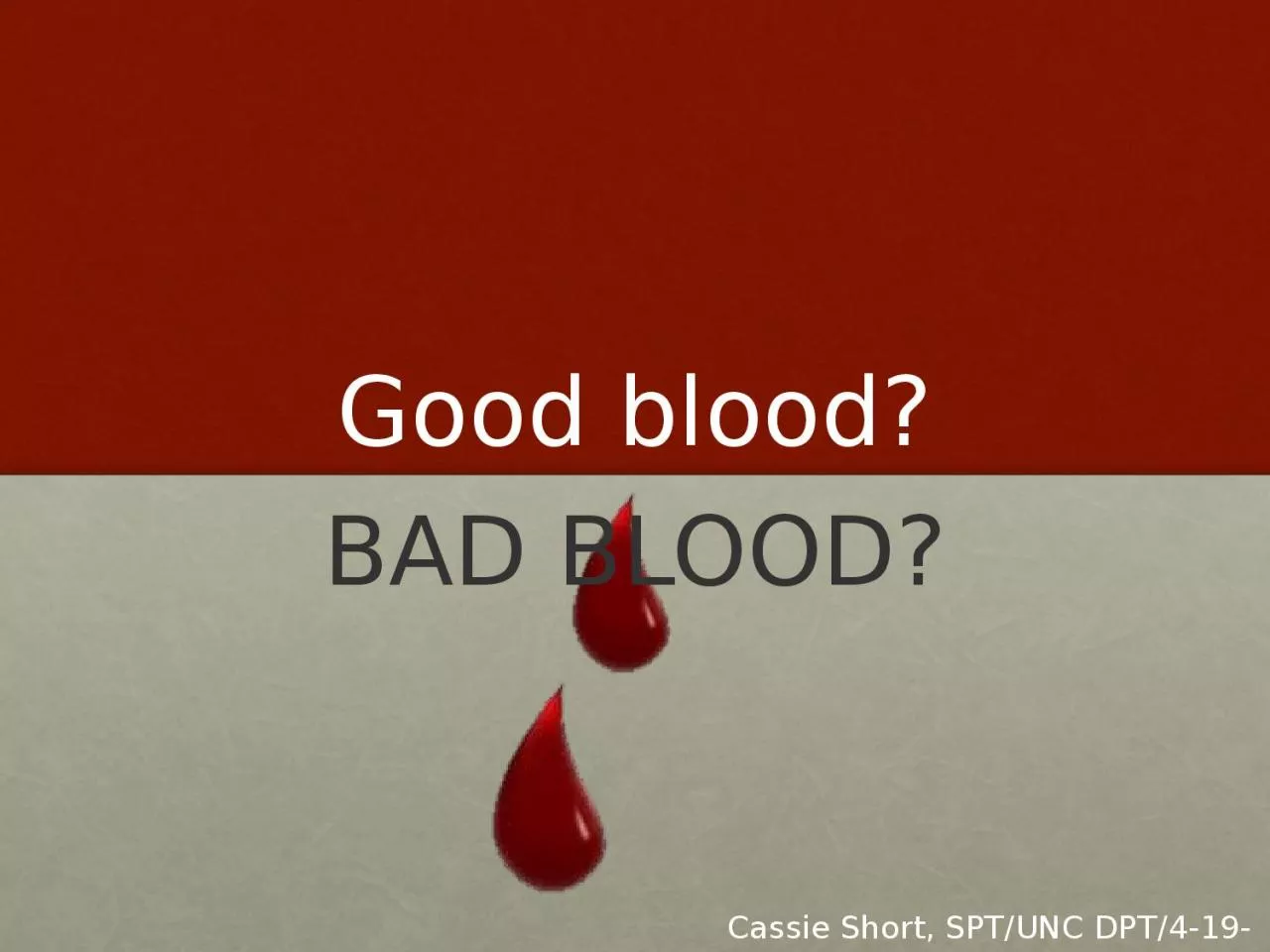

overview Case Study Examples Blood Transfusions Process Implications A dverse events Physical Therapy Contraindications Indications New Hanover Regional Medical Center Actions Case Study Examples ID: 1035860
Download Presentation The PPT/PDF document "Good blood? BAD BLOOD? Cassie Short, SPT..." is the property of its rightful owner. Permission is granted to download and print the materials on this web site for personal, non-commercial use only, and to display it on your personal computer provided you do not modify the materials and that you retain all copyright notices contained in the materials. By downloading content from our website, you accept the terms of this agreement.
1. Good blood?BAD BLOOD?Cassie Short, SPT/UNC DPT/4-19-12
2. overviewCase Study ExamplesBlood TransfusionsProcessImplicationsAdverse eventsPhysical TherapyContraindicationsIndicationsNew Hanover Regional Medical Center Actions
3. Case Study ExamplesMr. “A+”Mrs. “0+”
4. Case #1: Mr. “A+”Past Medical History:HTN, COPD, Ulcer Disease, ETOH, Hepatitis B, SmokerAdmit Date: 04/02/2012Diagnosis: MelenaHemoglobin at time of admit: 9.7g/L
5. Yes?NO?
6. Yes?NO?
7. Mr. “A+”Day 1: 5 Units *last measured Hb: 9.3g/LDay 2: 5 Units *Hb: 8.2g/LDay 3: 2 Units *Hb: 8.5g/LDay 4: 1 Unit *Hb: 9.5g/L___________________ = 13 UNITS*Total hospital stay = 13 days
8. Case #2: Mrs. “O+” PMHx:SOB, COPD, HTN, DM, CAD, L TKAAdmit Date: 03/04/12Diagnosis: COPD exacerbationHemoglobin at time of admission: 10.2g/L
9. Yes?NO?
10. Yes?NO?
11. Mrs. “o+”Day 1: 2 units *Last measured Hb: 11.1g/LDay 2: 0 units *Hb: 10.5g/LDay 3: 2 units *Hb: 10.9g/LDay 4: 1 unit *Hb: 11.6g/LDay 5: 0 units *Hb: 11.3g/L__________________________ = 5 UNITS*Total hospital stay = 9 days
12. Fact or Myth?Blood is safer than it’s ever been.A blood transfusion will get the patient home sooner.Blood transfusions improve healing.Blood is stored up to 42 days.Autologous blood (pre-donated) is risk-free.Blood transfusion is free.There is a 50% increased risk for infection per 1 unit of RBC’s.
13. Blood transfusionsProcessImplicationsAdverse Events
14. Blood transfusionsProcessAutologous or AllogenicSeparated into componentsTested for infectionsLeukoreductionPathogen Reduction TreatmentCompatibility TestingDonor cross-match testingDelivery for transfusion
15. ONE UNIT of RBCs42.5-80 g of Hemoglobin (128-240 mL of pure RBCs)147-278 mg of Iron (mostly in form of Hemoglobin)Increase hemoglobin level by ~1g/dL, Hematocrit by 3%Stored (refrigeration) 35-42 days; half life ~30 days; Frozen up to 10 years
16. Blood transfusionsIndications:Significant, life compromising, blood loss (trauma, surgery)Severe burn victimsWomen in childbirth and newborn babies (certain cases)Bleeding disorder or illness that causes anemia Contra-indications:Anemia that can be corrected with a non-transfusion therapy Source of blood volume, or oncotic pressureImprove wound healingSense of well-being*Avoid over-or under-transfusion*Based on clinical assessment and NOT lab values alone
17. Blood transfusionsHow can they go wrong?TRALI (transfusion-associated acute lung injury)TACO (transfusion associated circulatory overload)Acute/Delayed hemolytic reactionsFebrile, non-hemolytic reactionsAllergic reactionsTransmissible viruses (HIV, Hepatitis, or CMV))Bacterial contaminationsIncompatibility reactionsTransfusion inefficacy (storage lesion)Volume overloadHypothermia
18. Blood transfusionsBlood Storage LesionLess volume, flexibility of RBCs; increased adheranceRelease of free HbFormation of microparticlesNitric oxide interactionsAll of the above may be pro-inflammatory or pro-thrombotic- ultimately affecting delivery of 02 to tissuesProgresses over time
19. Blood transfusionsObjections to Blood TransfusionsPersonal, Medical, or Religious Jehovah’s WitnessesBelieve blood is sacred, the Bible says “abstain from blood” (Acts 15:28,29)Highlighted possible complications associated with transfusionDO accept non-blood alternatives to blood transfusionOther Options:Iron IV (for anemia) or supplementChanges in dietVolume expandersGrowth factorsBlood Salvaging or HemodilutionBlood substitutes
20. Blood transfusionsCase Study on Iron Deficiency Anemia*Randomized 459 patients with CHF and iron deficiency to receive either placebo or IV iron50% or treatment group reported, through Patient Global Assessment tool, NYHA functional class, and 6-minute walk test, being much or moderately improvedIV iron patients showed improved functional status regardless of Hb > or < 12g/dL prior to treatment
21. Physical therapyIndicationsContraindications
22. Physical TherapyIndicated if patient is asymptomatic of:FatigueSOBChest painHeadacheDizzinessPale skinNauseaVomiting Contra-indicated if patient is symptomatic of:FatigueSOBChest painHeadacheDizzinessPale SkinNauseaVomiting
23. Physical therapyWhat can we do as therapists?Be awareCheck hemoglobin prior to working with patientMonitor signs & symptoms of patients (before, during, or after transfusion) throughout your sessionCommunicate with their nurseEducate othersAsk questions!
24. New hanover regional medical centerTaking Action!
25. NHRMC~15,000 blood transfusions per yearCurrently working with Strategic Blood ManagementTM~20 transfusion safety officers throughout U.S.Educate, interact, provide tools for improvementLargest area noted for improvement with transfusion rate: Orthopedics2-3 year process
26. nhrmcGood ‘ol Epic!New order set for MD use for transfusionsOption to requestLast recorded hemoglobinDrop box choices for reasoningTransfusion “Triggers”Hemoglobin < 7g/LActive blood loss
27. nhrmcTransfusion CommitteeOversee if policies/procedures in place are being implementedTrendsChart audits for transfusion patientsMonthly Continuing EducationNursing staff on floorsWebinarsAny staff member of NHRMC
28. nhrmcAdverse Event Prevention/TreatmentNursing education on TACO & TRALI1 recorded in 2011Accuracy?Patient EducationConsent, risks, benefitsChoices
29. nhrmcQUESTIONS!?Tommy Barham, MT (ASCP) SM Manager- Blood Bank, Microbiology, Immunology 910-343-2776 or tommy.barham@nhrmc.org
30. QUESTIONS?Thank you!
31. Referenceshttp://www.bloodmanagement.comhttp://www.thebloodytruth.com/http://www.cms.hhs.gov/HospitalAcqCond/http://www.jointcommission.org/PerformanceMeasurement/PerformanceMeasurement/Blood+Management+-+Utilization.htmBoucher BA, Hannon TJ. Blood management: a aprimer for clinicians. Pharmacotherapy 2007: 27: 1394-411.Collins TA. Packed red blood cell transfusions in critically ill patients. Critical Care Nurse 2011; 31: 25-34.Dzik WH. Emily Cooley Lecture 2002: transfusion safety in the hospital. Transfusion 2003; 43: 1190-9.Goodnough LT. Risks of blood transfusion. [Review][124 refs]. Critical Care Medicine 2003; 31: S678-S686.Lion N, Crettaz D, Rubin O, Tissot JD. Stored red blood cells: a changing universe waiting for its map(s). J Proteomics. 2010. 73(3): 374-85.Roback J. Vascular effects of the red blood cell storage lesion. Hematology: Transfusion Medicine: adverse Complications of Stored Blood, Amer Soc Hematol, 2011.Stiller, K. Safety issues that should be considered when mobilizing critically ill patients. Crit Care Clin 2007. 23;35-53.Taylor RW, Manganaro L, O’Brien J et al. Impact of allogenic packed red blood cell transfusion on nosocomial infection rates in the critically ill patient. Crit Care Med 2002; 30: 2249-54.